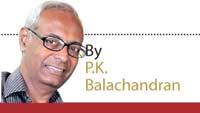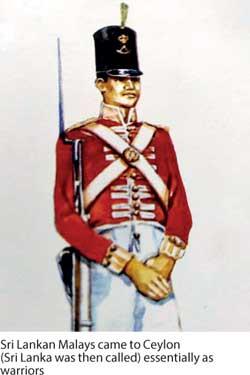Reply To:
Name - Reply Comment
 Sri Lanka’s tiny community of Malays (40,189 as per the 2012 census) had an overwhelmingly dominant position in the island’s military and police in the colonial period, thanks to the trust the Dutch and the British had in this immigrant group in the context of hostility from the indigenous Sinhalese.
Sri Lanka’s tiny community of Malays (40,189 as per the 2012 census) had an overwhelmingly dominant position in the island’s military and police in the colonial period, thanks to the trust the Dutch and the British had in this immigrant group in the context of hostility from the indigenous Sinhalese.
Sri Lankan Malays came to Ceylon (Sri Lanka was then called) essentially as warriors. The very first notable Malay to arrive was Chandrabhanu, the Buddhist king of Nakhon Si Tammarat in the Isthmus of Kra in the Malay peninsula, who came during the reign of Parakramabahu II (1236-1270). B.A. Hussainmiya author of Orang Regimen: The Malays of Ceylon Rifle Regiment quotes the Chulavamsa as saying that Chandrabahu “landed with a terrible Javaka (Malay) army under the treacherous pretext that they were also followers of the Buddha. All these wicked Javaka soldiers who invaded every landing place and who with their poisoned arrows like terrible snakes, without ceasing, harassed the people who they caught sight of, laid waste, raging in their fury, all Lanka.”
The ethnic group we now refer to as “Malay’ was, in ancient Lanka, called Javaka or Java, as they were basically from Java in the Dutch East Indies (modern Indonesia). According to inscriptions attributed to the South Indian Pandian king, Jatavarman Vira Pandyan (1235-1275), Chandrabhanu established himself in Northern Lanka. Indian historian Nilakanta Sastri says that in Kudumiyamalai Prasasti there is a reference to a Malayan king (Chavaka maindan) who ruled Jaffna. Hussainmiya says that footprints of Malayan rule can still be found in place names like Chavakacheri (Javaka settlement) and Jaffna (Javagama).
 In the 17 th. Century, the Dutch brought Javanese (who had become Muslim by then) from Batavia in the East Indies for various purposes. Some were exiled Princes and banished convicts and others were free Malays. Hussainmiya says that by the end of the 18 th.Century at least 200 princely families and their retinue were in Lanka. Some of the convicts were absorbed in the army of the then ruling Dutch East India Company (Vereenigde Oostindische Compagnie or VOC). In fact, the Malays were the single largest component of that army. As the territorial ambitions of the Dutch grew, the Batavian government dispatched troops annually, apart from reinforcements sent in times of emergencies, Hussainmiya notes.
In the 17 th. Century, the Dutch brought Javanese (who had become Muslim by then) from Batavia in the East Indies for various purposes. Some were exiled Princes and banished convicts and others were free Malays. Hussainmiya says that by the end of the 18 th.Century at least 200 princely families and their retinue were in Lanka. Some of the convicts were absorbed in the army of the then ruling Dutch East India Company (Vereenigde Oostindische Compagnie or VOC). In fact, the Malays were the single largest component of that army. As the territorial ambitions of the Dutch grew, the Batavian government dispatched troops annually, apart from reinforcements sent in times of emergencies, Hussainmiya notes.
Malay troops took part in Dutch campaigns against the Portuguese in Galle (1640); Colombo (1655-56); and Jaffna (1658). In 1658, a Malay force under its own Malay commander, went along with Dutch commander Rycklof van Goens, to attack the Portuguese on the Malabar coast in Kerala. Christopher Schweitzer wrote in 1680 that the Malays proved to be “very nimble and active in leaping and fencing” and that the Cingulayans (Sinhalese) were “mightily afraid” of them.
During the Kandyan wars in which the Kandyans employed guerilla tactics, the Dutch threw the Malays into the front as they could take on the Kandyans in close combat with their kris knives and short swords. By 1764, there were 2500 Malays in the Dutch forces. In 1795-96, when the British began to attack the Dutch, the Malays were the only ones to offer any resistance. Hussainmiya recalls that in 1795, the Malays led by Jaya Bangsa staged a daring attack on the British in Trincomalee, spiked their guns and killed several artillery men. They ambushed British troops as they landed in Beruwela and pushed them back into the sea. The Malays also attacked the British camp in Mutuwal with deadly “kisses and adder tongued daggers.”

The British were so impressed, that when they took over the maritime provinces from the Dutch in 1796, they made Malays a “permanent source of military manpower”. In 1802, Governor Frederic North sent Malays to fight against the Polygar rebels in Tamil Nadu. “They distinguished themselves by their active and indefatigable intrepidity,” North wrote to the Secretary of State in London.
North formed a “Malay Corps” with 1200 men and 22 European officers. The Corps was given the King’s Commission on 23/April/1801. On May 31, 1803, North presented the Corps its colors. At the function held in Gale Face Esplanade in Colombo, North said he had great pleasure “in presenting these Colors, not to a new Levy, but to a regiment whose past service is an earnest of future glory.”
North formed a Malay Boy’s Regiment to catch them young. The boys were given an English education which was useful when they were discharged in an era, when the British were setting up a civil administration. In addition to local Malays, the British recruited Malays serving with the Raja of Cochin in Kerala and Peninsular Malaya after the Dutch prevented recruitment from the East Indies. North offered Malays good pay and free passage for the family. If a Malay was killed in battle, the Government would look after his family, he said.
However, the response from the Malay peninsula was poor. Further, to the disappointment of North, Malay troops defected to the Kandyan side during the First Kandyan War in June 1803. Though this was due to incompetent British military commanders, North blamed the Malays for the British rout.
However, due to alienation from the cruel and insecure King of Kandy Sri Wickrema Rajasinghe, Kandyan Malays swung to the British side eventually. Governor Robert Brownrigg welcomed the Malays from Kandy from 1811 onwards. In 1813, Brownrigg recruited Malays from Java with the help of Sir Stamford Raffles, the British Lt.Governor of Java. The expanded Malay contingent helped the British defeat Sri Wickrama Rajasinghe in 1815 and capture him. This ended native rule in Sri Lanka.
In 1816 a batch of 228 Javanese soldiers of superior quality arrived in the island. In 1818, Malays helped the British suppress the Sinhalese rebellion in Uva. 1819 saw recruitment of Malays form Penang in Malaya.
In 1827, when peace was fully established in Ceylon, the government created a single native regiment, the Ceylon Rifle Regiment (CRR). Governor Edward Paget expanded the wholly Malay First Ceylon Regiment by adding African Roman Catholic Kaffirs and Hindu Sepoys from South India. But this was disliked by the Muslim Malays.
In 1830 there was a pay reduction done at the instance of the Home government even as Governor Edward Barnes protested. In 1833, the original pay was restored but by then, the Malays were seeking and getting employment in the civilian sector. The newly established police paid more than the army. According to Hussainmiya, in 1833, nine of the ten police sergeants were Malays and 75% of the constables were Malay. Writing in Sri Lanka Guardian Tuan M. Zameer Careem says that at that time, every police station became a “Malayu kampong” (Malay village).
“In fact, the first Ceylonese police officer who died during the course of his duties was a Malay constable named Sabhan who was shot dead on March 21st, 1864 in an attempt to apprehend the Highway Bandit Saradiel,” Careem points out.
With establishment of peace in the island and falling recruitment, keeping an army proved to be an unnecessary expenditure. Governor William Gregory disbanded the Ceylon Rifle Regiment on August 15, 1873, thereby ending the Malays’ long, and strong association with army.
After independence in 1947, in democratic Lanka, political and State patronage shifted wholesale from minorities like Burghers, Tamils, and Malays to Sinhala Buddhists, the majority community. This affected the military and police too. Only one Malay, Brig.T.S.B.Sally, rose to the highest position in the army and that too as an Acting Commander. However, the Eelam Wars in the 1980s and 1990s led to an expansion of the army and police, and a handful of Malays came to hold important commands. In the police, three Malays rose to Deputy Inspectors General level.